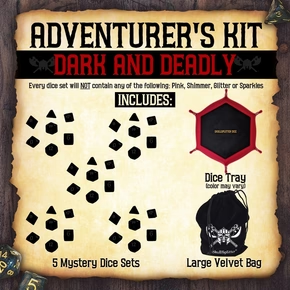
Cavalier 5e Guide
Hi-Ho Silver, AWAY!
Do you want to ride into battle, your mighty steed rearing and your coat of arms flying as you steady your lance for an epic charge? Cavaliers are the mounted fighters of 5e Dungeons & Dragons, excelling at combat on horseback (or camelback, or giant toad back Etc.) taking advantage of enhanced mobility and focusing enemy attention on themselves as a tank. But cavaliers are a bit of a black sheep among martial builds, with features that take a bit of work to really take advantage of. Get into the fighting spirit, shine up your armor, and clean out the stables as we go through everything you need to know.
Table of Contents:

What are Cavaliers?
Thematically, cavaliers are mounted combat specialists, your typical story of fantasy knights in shining armor on horseback trope. Mechanically, cavaliers are a Fighter subclass or "martial archetype", and sadly one of the weakest ones, you're not getting superiority die, an arcane shot, or the divine smite of a paladin, BUT with some creative building they can make for stylish and powerful tank characters. At their fundamentals they are still fighters, masters of martial combat and there are times and places where charging in on horseback is not only the best option strategically but it’s also glorious. Cavaliers are “knights” in the most classical form, heavily armored warriors on horseback, glorious heroes or a soul reaper on the hooves of the damned.
How Does Mounted Combat Work?
Legendary games have been won on horseback but when it comes down to the actual mechanics of riding a mounted creature, I see a lot of players get confused.
A mount is any creature with a size larger than you that’s willing to let you ride them. When you ride a horse, mule, camel, etc. you are riding a “controlled mount” and basically any pack animal or other domesticated creature is considered a “controlled mount”. Controlled mounts are easy to use but don’t do a whole lot. Essentially your movement speed increases because you get to use your controlled mount’s movement instead of your own, but they can’t take the attack action or really do anything else in combat other than serve to move you around faster.
A controlled mount can do three things in combat, the Dash, Disengage, and Dodge actions.
Most of the time you’ll either be using their action to dash and get into combat faster, or dodge just to keep themselves better protected.
When your mount is a bit more intelligent though, like a dragon or a griffon, it’s considered to be an “intelligent mount”, which gets a lot more complicated. An intelligent mount is its own independent character, it just happens to have you on its back. It can make the attack action, uses its own place in initiative, and is just generally not under your control in most combat situations. You can’t force it to do anything, and you’re really just along for the ride.
The dividing lines between a controlled mount and an independent mount are fuzzy, but generally if it’s a player character, is a wild animal (has no training), or has 4 or more Intelligence, it should usually be considered as an independent mount.
Cavalier Features
As a 5th edition fighter subclass, most of your features will actually be coming from the fighter class. For a more detailed analysis of those features you can find our article on the fighter class here. There you can also find info on the other martial archetypes, like eldritch knight, arcane archer, battle master, echo knight, purple dragon knight, psi warrior or rune knight.
For the cavalier’s unique archetype features, we should go through each of them and then dig into what they’ll actually do for your character. Here’s the raw text of the features:
Bonus Proficiency
When you choose this archetype at 3rd level, you gain proficiency in one of the following skills of your choice: Animal Handling, History, Insight, Performance, or Persuasion. Alternatively, you learn one language of your choice.
Born to the Saddle
Starting at 3rd level, your mastery as a rider becomes apparent. You have advantage on saving throws made to avoid falling off your mount. If you fall off your mount and descend no more than 10 feet, you can land on your feet if you’re not incapacitated.
Finally, mounting or dismounting a creature costs you only 5 feet of movement, rather than half your speed.
Unwavering Mark
Starting at 3rd level, you can menace your foes, foiling their attacks and punishing them for harming others. When you hit a creature with a melee weapon attack, you can mark the creature until the end of your next turn. This effect ends early if you are incapacitated or you die, or if someone else marks the creature.
While it is within 5 feet of you, a creature marked by you has disadvantage on any attack roll that doesn’t target you.
In addition, if a creature marked by you deals damage to anyone other than you, you can make a special melee weapon attack against the marked creature as a bonus action on your next turn. You have advantage on the attack roll, and if it hits, the attack’s weapon deals extra damage to the target equal to half your fighter level.
Regardless of the number of creatures you mark, you can make this special attack a number of times equal to your Strength modifier (minimum of once), and you regain all expended uses of it when you finish a long rest.
Warding Maneuver
At 7th level, you learn to fend off strikes directed at you, your mount, or other creatures nearby. If you or a creature you can see within 5 feet of you is hit by an attack, you can roll 1d8 as a reaction if you’re wielding a melee weapon or a shield. Roll the die, and add the number rolled to the target’s AC against that attack. If the attack still hits, the target has resistance against the attack’s damage.
You can use this feature a number of times equal to your Constitution modifier (minimum of once), and you regain all expended uses of it when you finish a long rest.
Hold the Line
At 10th level, you become a master of locking down your enemies. Creatures provoke an opportunity attack from you when they move 5 feet or more while within your reach, and if you hit a creature with an opportunity attack, the target’s speed is reduced to 0 until the end of the current turn.
Ferocious Charger
Starting at 15th level, you can run down your foes, whether you’re mounted or not. If you move at least 10 feet in a straight line right before attacking a creature and you hit it with the attack, that target must succeed on a Strength saving throw (DC 8 + your proficiency bonus + your Strength modifier) or be knocked prone. You can use this feature only once on each of your turns.
Vigilant Defender
Starting at 18th level, you respond to danger with extraordinary vigilance. In combat, you get a special reaction that you can take once on every creature’s turn, except your turn. You can use this special reaction only to make an opportunity attack, and you can’t use it on the same turn that you take your normal reaction.
Ok, now let’s take a look at each feature individually and how they really work.
Bonus Proficiency
As with any class feature that grants an extra skill proficiency or a language proficiency, you’re basically just choosing whatever you don’t already have. In most cases it’s here to give you animal handling proficiency since that’s not typically picked for Fighters and it’s one you’ll really want to pick up if you’re going around doing mounted combat. Any additional bonus proficiency is nice though, and I'll never sneeze at additional benefits.
Born to the Saddle
The strength or weakness of this feature depends on how much attention your DM pays to mounted combat rules. For a lot of players, falling off your mount wasn’t even something you were really worried about. The reason it’s in here as a full feature is this bit of the mounted combat rules:
If an effect moves your mount against its will while you're on it, you must succeed on a DC 10 Dexterity saving throw or fall off the mount, landing prone in a space within 5 feet of it. If you're knocked prone while mounted, you must make the same saving throw.
If your mount is knocked prone, you can use your reaction to dismount it as it falls and land on your feet. Otherwise, you are dismounted and fall prone in a space within 5 feet of it.
There are other fringe situations where your dungeon master might try to knock you off your horse of course, but this is the main one. Being forced to land prone can be nasty in some situations, prone people can get punished with heavy attack pressure if they’re out on the frontline, and as a cavalier that's exactly where you'll be. Still, it’s only a DC 10 save, and unless your DM is really trying for it getting shoved or knocked prone is a rare occurrence rather than a regular problem. Overall, this feature is pretty darn weak, it basically guarantees you’ll be able to stay mounted so you could argue that it’s necessary, but it’s not a major benefit regardless.
The second half of the feature that lets you mount or dismount with only 5 feet of movement is strangely a LOT more relevant most of the time. Normally mounting or dismounting costs you half of your movement, but as a cavalier it’s barely an inconvenience.
Unwavering Mark
Your other 3rd level feature is basically an improved challenge, but in a way that strangely doesn’t mesh well with what would otherwise be an ideal cavalier strategy.
When you hit somebody, you get to mark them out and make it an absolute pain for them to attack anybody but you because it gets disadvantage on attacks, and you threaten to smack them back with a bonus action attack on your next turn. This is excellent tank tech, but the extra attack with a damage bonus and the imposed disadvantage only really works if you stay in melee with them. Normally you’d want to take advantage of the freedom of movement a mount grants and harry the enemy, but this really shifts your style of combat towards charging in and sticking onto your opponent for all the damage potential.
The flip side of this though is that it does literally nothing if your enemy had no other targets in the first place. All that punishing tech for hitting targets other than you means nothing if the rest of your party is ranged and keeping back from the frontlines anyway.
It's also worth noting that this ability doesn't use your reaction, so you're free to make a reaction attack on top of all this, giving you a fair share of attacks even while using a shield.
Warding Maneuver
This 7th level ability is arguably the cavalier’s signature ability and is a huge benefit, and really cements you in as the tank/protector character. Even if the roll doesn’t stop an attack entirely, it’ll still halve the damage dealt by it. Meaning so long as you have a healthy Con modifier to use this feature multiple times per day, you’ll be able to blunt the biggest attacks your enemies can throw at you.
Hold the Line
Similar to the cheesy polearm master build, hold the line keeps your enemy locked in combat with you and since you’re the tank that’s exactly where you want them to be. This almost completely guarantees that once you hit an enemy in melee that you and that enemy will be fighting until one of you dies.
Ferocious Charger
Sadly, another dud feature, knocking a creature prone isn’t that hard to do at lower levels and as a 15th level feature it feels like a slap in the face. It also runs counterintuitively to the rest of the cavaliers’ features, since getting the most value out of this feature would involve charging and retreating repeatedly. But the cavalier really wants to charge in once and then stick in the fight. It doesn’t have a size limitation so you could theoretically knock things like dragons and giants prone with this, but the odds of such things failing Strength saves are usually pretty low.
Vigilant Defender
A pretty cool subclass capstone at 18th level that synergizes really well with your 10th level feature hold the line. Because you now essentially get to opportunity attack every enemy within range, you also get to lock those enemies in place with you. Basically, once you touch an enemy, they’re stuck to you for the rest of the fight.
Building a Better Cavalier
Ultimately cavaliers are a weird subclass. With the initial pretense of being the mounted combat specialist they do their best not to take advantage of the one real benefit of a mount which is their mobility. However, there’s still a powerful character build to be had here if built correctly.
Cavalier Ability Scores
When you build a cavalier, you are building a TANK. This means a high bonus to Strength for a high attack modifier and a bit of damage, then even more so than other tanks you care about Constitution. Because your arguably best feature warding maneuver gives you a number of uses equal to your Constitution ability modifier, you really want it as high as possible, not to mention all your other features revolve around making sure you take the hits for your allies so you're going to need every hit point. If you're trying to pour your ability score increases into your raw stats over feats, I'd recommend trying to hit max constitution over max strength since the Con will do you better than the odd strength score increase.
Beyond that, Dexterity has some value since the saves not to fall off your horse are Dexterity saves, but you don’t need much. I just advise against making it a dump stat and getting at least a flat +0 to the modifier.
As with most fighters, all the mental ability scores can really be dump stats for you other than the odd ability checks. If you have the room, Wisdom gives you the most value simply for it’s improvement to your Perception checks.
Cavalier Equipment
It should come as no surprise to you that the cavalier as a fighter with every armor proficiency should be taking heavy armor and a shield. You are a TANK and you want that AC as high as possible. For early levels this usually means taking chain mail, and then working your way up to full plate armor as soon as possible.
As for weapons, I must sadly inform you that the iconic lances are probably not your best option. You make each weapon attack at disadvantage with a lance when they’re within 5 feet melee range of you, and the cavalier wants to get stuck in and stay there. You’ll have one initial attack with a glorious lance charge attack and then fumble around for the rest of the combat. It’s boring, but I’d recommend a flail, longsword, or any other one-handed 1d8 martial weapon alongside a shield for an optimal combination of AC and damage output. I'd also specifically avoid using two-weapon fighting, since your unwavering mark feature that grants additional attacks relies on using your bonus action.
Horse Armor?
Under the barding rules, you can get armor for your mount at 4 times the cost. This means that yes, if you have enough cash you can buy your noble steed full plate armor. These armors grant the mount the same AC values as they would you, they just cost more and you usually need to get them custom made at a blacksmith.
I recommend getting scale mail for your mount until you can afford the plate, it’s relatively cheaper (scale mail barding should cost 200 gp) and it would grant a warhorse a respectable AC of 15.
Cavalier Fighting Styles
There isn’t a mounted combat specific fighting style (which is a real shame) and I’m sad to say the “right” answer for a cavalier’s fighting style is probably boring old Defense. +1 AC is a big deal, and as the tank that is very specifically trying to draw all the aggro you really need as much AC as you can get.
Mounted Combatant
We can’t talk about any cavalier build without talking about what is arguably their must-have feat option. Many of the best fighter feats just don't work for the cavalier but the mounted combatant feat was basically tailor made for them. Mounted combatant does three things:
- Advantage on attacks targeting creatures smaller than your mount.
- Melee attacks on your mount target you instead (optionally).
- If you pass a save against a fireball (any dexterity saving throw source of damage) you mount takes no damage, and only half if you fail.
All of this combines to make mounts a lot more viable, and a heck of a lot more deadly. Assuming you’re fighting a medium creature or smaller, you basically get permanent advantage on your attacks against them (it also makes the lance build a real possibility, since at worst you’d be making attacks normally with it, in which case I'd also recommend taking great weapon fighting and great weapon master). Pure advantage on melee attack goodness is hard to come by and can validate making a mounted build on its own.
Mounted combatant gives you a major advantage, while essentially ensuring that your mount will survive the combat (most of the time). I highly recommend taking it at 4th level with your first feat opportunity, especially since as a fighter you’re more feat-rich as it is.

Disclaimer
Last updated: January 27, 2019
The information contained on www.SkullSplitterDice.com website (the "Service") is for general information purposes only.
www.SkullSplitterDice.com is a participant in the Amazon Services LLC Associates Program, an affiliate advertising program designed to provide a means for sites to earn advertising fees by advertising and linking to Amazon.com. (source: Section 5)
Blueshift Nine, LLC assumes no responsibility for errors or omissions in the contents on the Service.
In no event shall Blueshift Nine, LLC be liable for any special, direct, indirect, consequential, or incidental damages or any damages whatsoever, whether in an action of contract, negligence or other tort, arising out of or in connection with the use of the Service or the contents of the Service. Blueshift Nine, LLC reserves the right to make additions, deletions, or modification to the contents on the Service at any time without prior notice.
Blueshift Nine, LLC does not warrant that the Service is free of viruses or other harmful components.
Affiliate disclaimer
This affiliate disclosure details the affiliate relationships of Blueshift Nine, LLC with other companies and products.
Some of the links are "affiliate links", a link with a special tracking code. This means if you click on an affiliate link and purchase the item, we will receive an affiliate commission.
The price of the item is the same whether it is an affiliate link or not. Regardless, we only recommend products or services we believe will add value to our readers.
By using the affiliate links, you are helping support the Service, and we genuinely appreciate your support.
Affiliate advertising programs that the Service uses are:
- Amazon Services LLC Associates Program
- As an Amazon Associate, I earn from qualifying purchases.
- Blueshift Nine, LLC is a participant in the Amazon Services LLC Associates Program, an affiliate advertising program designed to provide a means for sites to earn advertising fees by advertising and linking to Amazon.com or endless.com, MYHABIT.com, SmallParts.com, or AmazonWireless.com.
- Pages on this Service may include affiliate links to Amazon and its affiliate sites on which the owner of this Service, Blueshift Nine, LLC, will make a referral commission.


